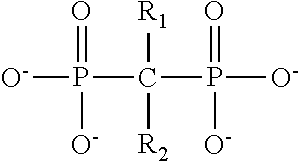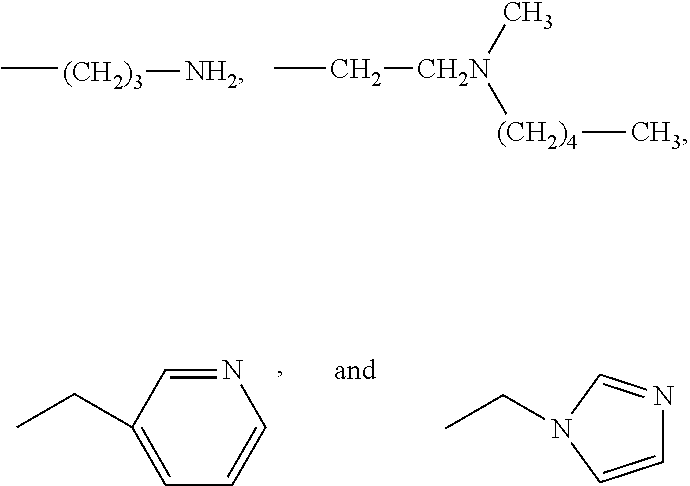Biocompatible fibrinogen matrix on a solid support
a fibrinogen matrix and solid support technology, applied in the field of orthopaedic implants, can solve the problems of protein restriction in its mobility, and cannot be ruled out the fibrinogen of the prior
- Summary
- Abstract
- Description
- Claims
- Application Information
AI Technical Summary
Problems solved by technology
Method used
Image
Examples
example 1
Screws with Ten-Layers of Cross-Linked Fibrinogen and the Bisphosphonates Pamidronate and Ibandronate were Prepared, Followed by Deactivation with Gamma-Irradiation
[0051]Stainless steel screws, with threads measuring 1.7 mm in diameter and 3 mm in length were used. The screw specimens were cleaned for five minutes in acetone in an ultrasonic bath. The specimens were then etched during twenty minutes in 100% hydrofluoric acid (HF) and washed in a basic hydrogen peroxide solution at 80° C. for five minutes and finally rinsed in distilled water. Holes and asperities in the size range 0.1-100 micrometers were observed on the etched surface.
[0052]The screw specimens were put in a chamber with 0.2M 3-aminopropyltriethoxysilane H2N(CH2)3Si(OC2H5)3 (APTES from ABCR, Germany) and baked at 60° C. at 6 mbar for ten minutes. The temperature was then increased to 150° C. for one hour. The surfaces of the specimens were rinsed for two minutes in xylene (99% concentration, Merck, USA) in an ultras...
example 2
Screws with a Non-Clottable Fibrinogen Matrix of Ten-Layers of Fibrinogen and the Bisphosphonate Pamidronate are Prepared in the Following Way
[0058]Stainless steel screws, with threads measuring 1.7 mm in diameter and 3 mm in length are used. The screw specimens are cleaned for five minutes in acetone in an ultrasonic bath. The specimens are then etched during twenty minutes in 100% hydrofluoric acid (HF) and washed in a basic hydrogen peroxide solution at 80° C. for five minutes and finally rinsed in distilled water. Holes and asperities in the size range 0.1-100 micrometers could be observed on the etched surface.
[0059]The screw specimens are put in a chamber with 0.2M 3-aminopropyltriethoxy-silane H2N(CH2)3Si(OC2H5)3 (APTES from ABCR, Germany) and baked at 60° C. at 6 mbar for ten minutes. The temperature is then increased to 150° C. for one hour. The surfaces of the specimens are rinsed for two minutes in xylene (99% concentration, Merck, USA) in an ultrasonic bath. The surfaces...
example 3
Screws with a Non-Clottable Matrix of Eight-Layers of Fibrinogen and the Bisphosphonte Pamidronate are Prepared in the Following Way
[0063]Titanium screws were used coated with bisphosphonate. The screws were cleaned in acetone (100%, 3 min, at room temperature) and ultrasonicated 5 minutes and rinsed in distilled water. Screws were then further cleaned in UVO-chamber for 4 minutes times 4 (turned 90 degrees in between). Then they were incubated in 1% APTES in Xylene for 30 minutes, rinsed in Xylene and dried in flowing nitrogen. Thereafter screws are incubated in 6% glutaraldehyde in PBS pH 8.5 for 30 minutes, rinsed in destilled water and dried in flowing nitrogen. First layer of fibrinogen was attached by 30 minutes incubation in a 1 mg / ml fibrinogen solution in PBS, pH 7.4. Second and following layers were linked to the previous by use of repetive EDC / NHS and fibrinogen treatments, as described above. A total of 8 layers of fibrinogen result in an approximately 530 Å thick crossl...
PUM
| Property | Measurement | Unit |
|---|---|---|
| Hydrophobicity | aaaaa | aaaaa |
| Biocompatibility | aaaaa | aaaaa |
Abstract
Description
Claims
Application Information
 Login to View More
Login to View More - R&D
- Intellectual Property
- Life Sciences
- Materials
- Tech Scout
- Unparalleled Data Quality
- Higher Quality Content
- 60% Fewer Hallucinations
Browse by: Latest US Patents, China's latest patents, Technical Efficacy Thesaurus, Application Domain, Technology Topic, Popular Technical Reports.
© 2025 PatSnap. All rights reserved.Legal|Privacy policy|Modern Slavery Act Transparency Statement|Sitemap|About US| Contact US: help@patsnap.com



